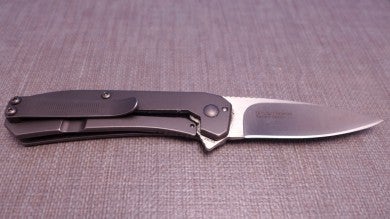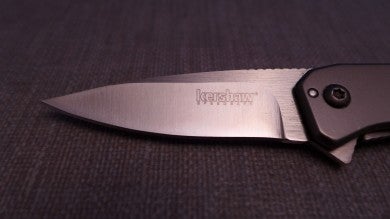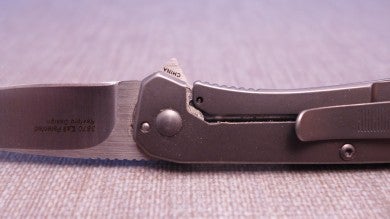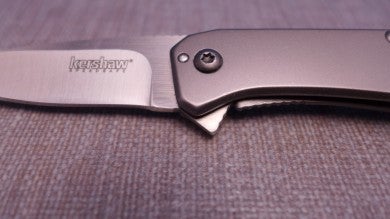Review: Kershaw Amplitude
Tony Sculimbrene 02.10.15

KAI USA, Kershaw and ZT’s parent company, is a daring company. They take all comers, challenging Gerber and other brands at the bottom of the market, and slugging it out with any manufacturer or custom maker at the top of the market with designs like the Tilt and the ZT0888 MAX. So it comes as little surprise that they are willing to make budget versions of Todd Rexford designs.
For those that don’t know, Todd Rexford has a special place in the pantheon of custom makers working in the modern style. His work is renowned for its simplicity in appearance and its mechanical perfection. It’s not unheard for Rexford customs to sell for ten times more on the secondary market compared to what Rexford charges for them direct. His rendition of the Dauntless sold direct from TAD for $600 and appeared (then disappeared) on forums for over $5000. His three main models, the Epicenter, the Singularity, and the Amplitude are all highly sought after blades. And KAI, bold as they are, dare to make their version of the Singularity, the ZT0801 and ZT0801CF, with plenty of flourish. Both are great production knives. But they ventured out even further on a limb when they released two budget Rexfords, the small and large Injections. Both were surprisingly great. It’s rare to find Rolex designs in budget form, and rarer still to those transitions successfully made.
The Amplitude is an even bolder stroke still. Unlike the earlier designs, which were pastiches of Rexford knives, the Amplitude is a budget version of a custom knife of the same name. This is an effort by KAI to directly convert a Rexford design into a knife that sells for under $30.
Description
The Amplitude is a small folder designed for everyday carry/utility tasks (such as light food prep, box and package opening, cutting random threads off clothing, processing stuff for recycling bins, and the like).
It has stainless steel handles and an 8Cr13MoV blade. The knife is an assisted flipper design. The blade is a hollow ground spear point design. The knife also includes a pocket clip with a standoff, a feature that echoes back to the Rexford custom. It is a framelock. The blade itself is about 2.5 inches long, and the knife weighs around 3 ounces. The knife is made in China by an OEM (original equipment manufacturer, aka a contractor) working for and with KAI USA.
Testing
This knife arrived during the holiday season, so it got a ton of work both breaking down boxes and helping with wrapping gifts (I used it instead of scissors). It also, of course, got a good deal of work doing regular EDC tasks: depitting cherries for my four year old son’s lunch, slicing apples, opening boxes, etc. Given its size and construction, I did not use it at all in the woods. During the testing of the Injection, I thumped on that knife pretty hard. I did not do the same here. The blade is both too small and too thin to do that comfortably.
Design
The overall appearance of the Amplitude is very Rexford-ish–clean, simple, with elegant lines.
The flipper tab does break that up a bit, appearing much too large for a knife of this size. It does give you a firm position from which to kick the blade open, but it is a bit garish. The blade shape is exceptionally thin at the tip, but it is also an amazing slicer.
This thing cut apples like a kitchen knife. I like the clip a great deal as well, with the little riser doing a good job of mimicking a fully sculpted clip like you would find on a custom Rexford. In all, this is a passable rendition from the perspective of pure design, of a Rexford. It lacks a bit of the flair the Injection had, with its milled handles, good looking pivot, and unusual thumb studs, but this is a cleaner design to being with, even in its custom form.
Implementation
For all of the strengths the knife has in its design, it is disappointing in its implementation. My version of the knife, the specific unit I own, demonstrates a number of failures when it comes to fit and finish, some of which are just annoying quirks that bother knife knuts while others are genuine concerns.
First the lock bar is very thin, and the lock bar cut is extra wide. Aesthetically it looks weak and messy. It also allows for gunk to get into the knife more easily. This is a knit-picky thing. But the other issue is more problematic. My unit has not just a little bit of blade play and lock rock, but a huge amount.
Here is a quick aside on blade play and lock rock, for those not familiar with the terms and how to assess the problem:
Blade play is when the blade moves up and down and/or side to side, even when locked. Lock rock is when movement in the blade/lock assembly causes the lock to move out of place or slip around on the tang (the rear part of the blade where the blade and lock meet).
I basically think of blade play/lock rock in three categories–tactile, audible, and visible. If you can take the knife and feel the blade moving around or the lock wiggling out of place, it’s not great. This is tactile blade play. While it’s not great, lots of knives, even brand new ones, have a bit of this level of blade play. The human fingers are amazingly precise instruments, capable of feeling differences in thickness of about 1/1000th of an inch, so while less than ideal, tactile blade play is never a deal breaker for me. Additionally there are designs, lock backs, that have this almost inherently. Again, a concern but not a really big problem.
More concerning is audible blade play/lock rock. Here movement on the blade causes noise–usually a clicking between the lock and the blade. This is worse for two reasons. First it means that the parts aren’t contacting each other and the subsequent forced contact may cause uneven or unintended wear. Second, it means that the gaps in the knife are bigger (usually) than those present in merely tactile blade play.
Finally, there is visible blade play. Be careful when looking because it’s possible for your eyes to be fooled. Just like the old rubber pencil trick from elementary school, if you move your hands a lot, it can look like there is blade play or lock rock. It’s best to focus not on the tip of the blade, but where the blade and lock interface. I have found over the years that if you can see the blade play and the lock moving, you can always hear and see it as well. Visible blade play is the worst because, in this one scenario, your eyes are the least precise of your senses. Most people can’t hope to see a 1/1000th of inch difference in size, even if their finger tips can feel it all day long.
In my particular Amplitude, the blade play is very significant and the lock rock is present. I have yet to disengage the lock by inducing lock rock, but I don’t think it would be impossible. I also don’t think this is necessarily a lemon. The design of the lock bar and blade tang is very unusual on the Amplitude. The lock bar appears to be intended to interface with the knife tang both at the end of and the top of the lock bar. Mine misses the top interface area by a substantial degree. It might also be that the blade tang isn’t supposed to have a two surface interface and instead is merely cut that way. This also presents an implementation problem. The knife appears to have an internal stop pin (that is, a pin near the pivot that rides in a race or cut out in the blade and is not visible from the outside of the knife; this is opposed to an external stop pint). Internal stop pins generally require more precision to implement and here, if the two surface interface theory is incorrect, the problem exists with the internal stop pin.
Either way, whatever the cause, my particular Amplitude has exhibited unacceptable amounts of blade play, play that is significant enough to suggest the possibility of real failure in the future. Parts will wear over time and poorly interfacing parts will wear quicker. This knife has a problem and its quirky design leads me to think it is emblematic of the entire line, not just a problem with my unit.
I did my due diligence and contacted Kershaw about this via the Contact Form on their website on January 6, 2015. On January 26, 2015 I received a response. It stated that Kershaw’s warranty department could not comment on the design features and then gave me instructions on how to return the knife for a warrant repair. I am not going to fork over $4 to ship a knife that costs $25. Additionally, with comments from Dan of Blade Reviews on the similarly price Nura 3.0, I think it’s safe to say this is an issue endemic to certain cheaper Kershaw knives.
A cursory survey of trusted reviewers on the Internet and commenters on my own video overview confirms that the Amplitude, while a good looking package, isn’t quite hitting on all cylinders. It might be the complexity of taking a Rexford design and making it for much less. It might be the unusual lockbar or the sloppy tolerances on the internal stop pin. Whatever the cause, the Amplitude isn’t up to KAI USA’s usual high standards. And before folks point to the price–my $7 San Ren Mu 605 had flawless fit and finish. Same materials (8Cr), same country of origin (China), same role (small EDC knife), and about one quarter the price.
The shape is pleasing to the eye except for the overly large flipper tab, but the knife itself is just not right. Save your pennies a little longer and just go to your local Dick’s to pick up the non-catalog Zing in G10 with a blackwash blade. I was going to recommend the Nura 3.0, but it had the same problems. Skip the Amplitude. It’s not even worth the $25 asking price.



